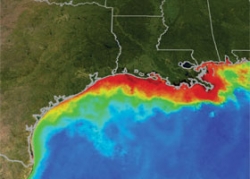
The low-oxygen or “dead zone” portions of the Gulf of Mexico stretch across thousands of miles. The lowest oxygen levels appear in red. © NASA/NOAA
We in the Chesapeake Bay watershed are not the only ones dealing with large dead zones caused by agricultural waste like nitrate- and phosphate-containing fertilizers, and other toxins including sewage runoff, animal waste and car exhaust.
A recent article in E – The Environmental Magazine states that scientists predict a “dead zone” in the Gulf of Mexico could expand to between 8,500 and 9,421 square miles this year, roughly the size of New Jersey and Delaware combined. Dead zones are oxygen-depleted, lifeless expanses of water. The dead zone in the Gulf, 60 miles off the coasts of Louisiana and Texas, is one of the largest in the world and has more than doubled since the 1980s. In 2002, a staggering 8,400 square miles of the Gulf was “hypoxic” or lacked sufficient oxygen for most marine life to live.



Write a Letter to the Editor on this Article
We encourage readers to offer their point of view on this article by submitting the following form. Editing is sometimes necessary and is done at the discretion of the editorial staff.